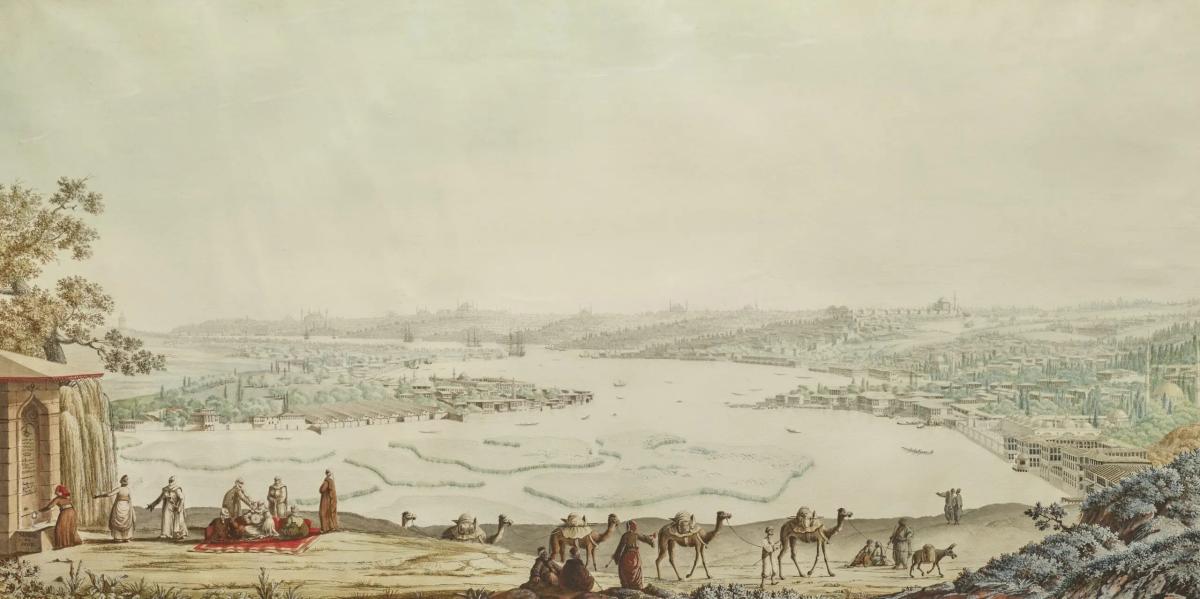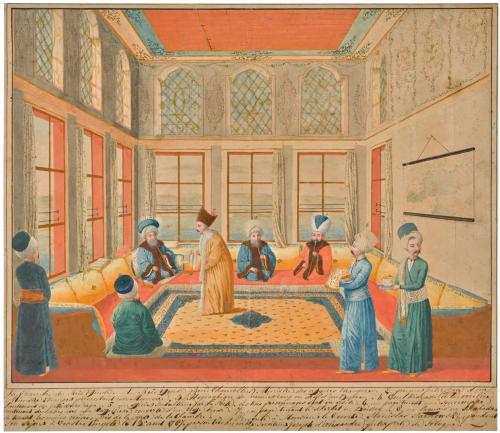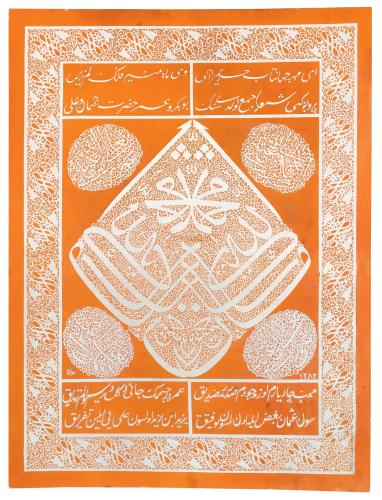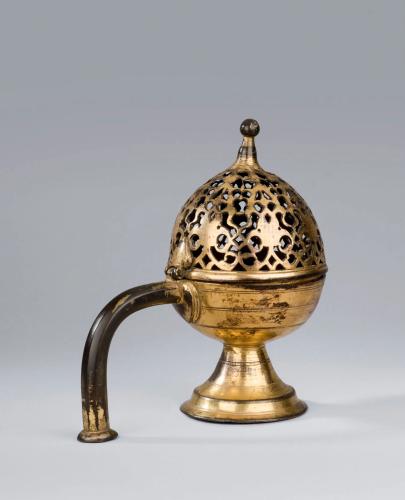

Price on application
This object is eligible for a Certificate of BADA Provenance
The BADA Standard
- Since 1918, BADA has been the leading association for the antiques and fine art trade
- Members are elected for their knowledge, integrity and quality of stock
- Our clients are protected by BADA’s code of conduct
- Our dealers’ membership is reviewed and renewed annually
- Bada.org is a non-profit site: clients deal directly with members and they pay no hidden fees
An Exceptionally Rare Panoramic View of Constantinople By Antoine-Ignace Melling, Court Painter To Sultan Selim III’s (R. 1789-1807) Sister Hatice Sultan & Napoleon’s Wife Empress Josephine.
"View of Constantinople from Eyup"
Charcoal, Indian ink, Watercolour and Gouache on Paper
Signed and Dated: “Melling An 1802”, also signed in Arabic/Ottoman letters “sawwada Melling 1802” (Melling drew this, 1802).
Dimensions: 47 x 94 cm.
This panoramic painting is almost identical to the view published in Voyage Pittoresque de Constantinople et des Rives du Bosphore, Paris, Strassburg, London, Treuttel et Würtz, 1809-1819, Pl. 5 (Vue général du Port de Constantinople prise des hauteurs d’Eyoub).
In this painting, Melling depicts the city of Constantinople, as seen from the district of Eyüp Sultan, overlooking the Golden Horn (Haliç). On the left, there are ladies pick-nicking and a servant fetching water from the fountain. In the middle, camels, led by a donkey, are moving toward the right. Melling depicts the panoramic view, the monuments, buildings and different aspects of the city’s daily life with meticulous accuracy and attention to detail.
Beyond, to the left, is the clear outline of the Galata Tower. At the end of the Golden Horn, behind the old city walls is the dome of the great Hagia Sophia, the sixth century Byzantine church that became a mosque in 1453. The painting also captures the Sultan Ahmed Mosque (the Blue Mosque), the Bayezid Mosque, the Süleymaniye Mosque, the Fatih Mosque, and the Mihrimah Sultan Mosque, and lastly the early 19th century mosque complex enclosing the shrine at Eyup to the lower right.
In this painting, Melling documents a highly original aspect of the city’s urban history; the 18th century waterside-mansions on the Golden Horn. There were many waterside mansions owned by members of the Ottoman palace circle in Eyup and the neighbouring districts, most important of all, the Valide Yalısı (the Sultan’s mother’s waterside-mansion). Throughout the 18th century waterside-mansions on the Golden Horn were very fashionable among the elite until the increasing interest in the waterside-mansions on the Bosphorus in the 19th century.
The Eyup district has a special place in the history of Constantinople. Five years after the conquest of the city by the Turks in 1453, a mosque was built in this neighbourhood, that was named after Ayyub al-Ansari (Eyüp in Turkish), a companion of the Prophet Muhammad who fell in the First Arab Siege, in 674-8 C.E. The mosque in particular and the Eyup district in general are thus greatly revered and visited almost like a place of pilgrimage by Muslims.
According to the French envoy’s secretary M. de Monconys in 1648, the Okmeydanı district was a favourite spot for the French ambassador and the French tourists. By the late 18th century Okmeydanı left its place to Eyup. Perhaps for this reason Melling produced some of his best quality drawings from Eyup. Auguste Boppe, Les Orientalistes – Les Peintres du Bosphore au XVIIIe Siècle, ACR Edition, Paris, 1989, p. 235. For a similar view by Melling with a view from Eyup please see, Ibid, 1989, p. 249.
Here, in addition to his signature and date, in the Latin alphabet and numerals, Melling signed his name and dated this piece in Arabic/Ottoman letters and numerals. At the end of the fountain’s foundation inscription, the last three lines read “sawwada Melling 1802” (Melling drew this 1802).
The present painting is important both in terms of its artistic value and as a historical record documenting the view of Constantinople from the Eyup district in the year 1802.
Watercolours by Melling are extremely rare and only a few have appeared on the market:
Melling’s Vue de la première cour intérieure du sérail à Constantinople was sold at Sotheby’s Paris, in 29 October 2008, Lot 6, for €480,750.
His Caïques devant le Place et les Casernes de Tophané was sold at Gros & Delettrez, in 18 June 2012, Lot 158, for €600,000.
His Vue du Bosphore prise à Kandilly was sold at Gros & Delettrez, in 18 June 2012, Lot 159, for €550,000.
Court Artist Antione-Ignace Melling (d. 1831)
Born in 1763 in Karlsruhe, Baden, Antoine-Ignace Melling was brought up by his uncle in Strassburg. In 1785 he arrived in Istanbul as a member of the Russian ambassador’s retinue. He drew pictures for the ambassadors of Britain and the Netherlands. Later, the Danish envoy Baron Hubsch von Grossthal introduced him to Sultan Selim III’s sister Princess Hatice Sultan (1766–1822). Hatice Sultan was a patron of the arts and a remarkable collector. She preferred Dresden or Sevres porcelain rather than China. After visiting Hubsch’s European garden at the neighbourhood of Büyükdere on the Bosphorus, Hatice Sultan told Hubsch that she wanted a European garden. Hubsch recommended Melling and Hatice Sultan became his patron for 18 years. During this period Melling worked as her personal painter, architect and garden designer and eventually became her closest companion. Auguste Boppe, Les Orientalistes – Les Peintres du Bosphore au XVIIIe Siècle, ACR Edition, Paris, 1989, p. 249.
After designing Hatice Sultan’s European garden Melling redecorated her palace. Soon, a neoclassical palace for the princess arose at the Defterdarburnu district on the Bosphorus. Melling also designed dresses, cutlery and furniture for the princess and kiosks for Selim III and his mother at Beşiktaş. Hatice Sultan wrote letters to Melling in Ottoman Turkish penned in the Latin alphabet which he may have taught her.
Melling’s closeness to Hatice Sultan opened many doors for him while he lived in the Ottoman capital and he was introduced to many members of the Ottoman elite. He and his friend Jacob Ensle (Selim III’s chief gardener) had limitless access to the imperial palace. Ibid, 1989, p.257. Eventually, Melling became permanent member of Selim III’s stately ceremonies. He reflected his impressions from the sultan’s Friday prayer processions, visiting ambassadors’ processions, janissaries’ ceremonies, imperial feasts to his paintings with amazing attention to detail and accuracy. He was permitted to walk and converse with harem ladies from Hatice Sultan’s circle in the palace gardens; a rare privilege for a foreigner. Ibid, 1989, p. 248. Until 1803 he lived in Constantinople and painted rich and vivid views of the city. In his paintings he depicted many of the people he had met in real life. Ibid, 1989, p. 242. He went to. Paris in 1803 with his Levantine wife Francoise-Louise Colombo. There he published a prospectus for the Voyage pittoresque de Constantinople et des rives du Bosphore. With the help of Talleyrand he was appointed landscape painter to the Emperor Napoleon’s wife, the Empress Josephine. Please see, https://www.britishmuseum.org/collection/term/BIOG38088
By 1809 he had set up an engraving studio for the purpose of reproducing completed images of his drawings. A series of facsimiles were sent out to subscribers, between 1809 and 1819. Etchings with engraving by Schroeder, Duplessi-Bertaux, and Pigeot after Melling, were produced with later professional hand-colouring. On 25 August 1819, the magnificent folio volume, Voyage pittoresque de Constantinople et des rives du Bosphore was finally published with the financial support of the French government. In 1831 Melling died in Paris as a celebrated artist.
The Nobel-Prize-winning Turkish novelist, Orhan Pamuk dedicates a whole chapter to Melling in his autobiographical memoir, Istanbul: Memories and the City. Pamuk claims that Melling “saw the city like an Istanbulite but painted it like a clear-eyed Westerner”.
Accurate and elegant, Melling’s drawings document the meetings of two different cultures; a western artist working for an Ottoman princess in Constantinople, during the reign of Selim III.
Provenance
Contre-Amiral Eugène-Marie Le Leon (1848-1937), in the family collection since 1880, thence by descent to Le Leon’s great-grand daughter.
Contre-Amiral Eugène-Marie Le Leon (1848-1937)
Eugène-Marie Le Leon was born in Lorient, in 16 June 1848. His first official expedition was to Sibylle, in 1867. In 1870 he travelled to the North Sea. He was appointed lieutenant in 1876. In 1877 he led his first expedition as captain. Later, he followed the battle between Peru and Bolivia in the Pasific Ocean. He was appointed captain to Oche. He became contre-amiral (rear-admiral) in 1907. He held the following posts: Major General of the 3rd maritime district and commander of the Lorient arsenal, then placed in the reserve section in 1910. He received the Légion d’Honneur in 1889.
He published Souvenirs d’une Mission a L’armée Chilienne: Batailles de Chorrillos et de Miraflores in 1883. In the photograph accompanying this text, he wears rear admiral’s full dress model 1902 with black feathered cocked hat. He wears the single row embroidered tunic with a single row of buttons for General Officers. He also wears the following medals: Officer of the Légion d’Honneur, Commemorative Medal of the Madagascar Expedition, Colonial Medal, Commander of the Crown of Italy, Medal of Mejidiye of the Ottoman Empire. Le Leon died in 1937.
Dimensions
47 x 94 cmThe BADA Standard
- Since 1918, BADA has been the leading association for the antiques and fine art trade
- Members are elected for their knowledge, integrity and quality of stock
- Our clients are protected by BADA’s code of conduct
- Our dealers’ membership is reviewed and renewed annually
- Bada.org is a non-profit site: clients deal directly with members and they pay no hidden fees




